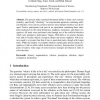Free Online Productivity Tools
i2Speak
i2Symbol
i2OCR
iTex2Img
iWeb2Print
iWeb2Shot
i2Type
iPdf2Split
iPdf2Merge
i2Bopomofo
i2Arabic
i2Style
i2Image
i2PDF
iLatex2Rtf
Sci2ools
94
Voted
HAPTICS
2010
IEEE
2010
IEEE
What Is It Like to Be a Rat? Sensory Augmentation Study
The present study examined the human ability to learn a new sensory modality, specifically "whisking". An experimental apparatus containing artificial whiskers, force sensors, position sensors and computer interface was developed. Twelve participants took part in an experiment containing three tasks: pole localization in the radial dimension, roughness estimation, and object recognition. All tasks were performed only through use of the artificial whiskers which were attached to participants' fingers. With little or no practice humans were able to localize objects, recognize shapes and assess roughness with accuracy equal to or greater than that of rats in equivalent tasks, though with longer times. While the number of available whiskers significantly affected shape recognition, it did not affect radial localization accuracy. Introspection by participants revealed a wide range of motor-sensory strategies developed in order to solve the tasks.
Artificial Whiskers | HAPTICS 2010 | Human Computer Interaction | Radial Localization Accuracy | Roughness Estimation |
| Added | 03 Mar 2011 |
| Updated | 03 Mar 2011 |
| Type | Journal |
| Year | 2010 |
| Where | HAPTICS |
| Authors | Avraham Saig, Amos Arieli, Ehud Ahissar |
Comments (0)

